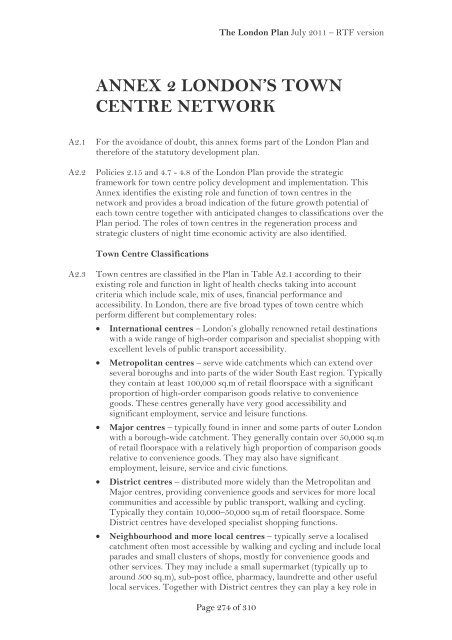London Plan 2011 PDF 1 MB - Lambeth Council
London Plan 2011 PDF 1 MB - Lambeth Council
London Plan 2011 PDF 1 MB - Lambeth Council
You also want an ePaper? Increase the reach of your titles
YUMPU automatically turns print PDFs into web optimized ePapers that Google loves.
The <strong>London</strong> <strong>Plan</strong> July <strong>2011</strong> – RTF version<br />
ANNEX 2 LONDON’S TOWN<br />
CENTRE NETWORK<br />
A2.1 For the avoidance of doubt, this annex forms part of the <strong>London</strong> <strong>Plan</strong> and<br />
therefore of the statutory development plan.<br />
A2.2 Policies 2.15 and 4.7 - 4.8 of the <strong>London</strong> <strong>Plan</strong> provide the strategic<br />
framework for town centre policy development and implementation. This<br />
Annex identifies the existing role and function of town centres in the<br />
network and provides a broad indication of the future growth potential of<br />
each town centre together with anticipated changes to classifications over the<br />
<strong>Plan</strong> period. The roles of town centres in the regeneration process and<br />
strategic clusters of night time economic activity are also identified.<br />
Town Centre Classifications<br />
A2.3 Town centres are classified in the <strong>Plan</strong> in Table A2.1 according to their<br />
existing role and function in light of health checks taking into account<br />
criteria which include scale, mix of uses, financial performance and<br />
accessibility. In <strong>London</strong>, there are five broad types of town centre which<br />
perform different but complementary roles:<br />
• International centres – <strong>London</strong>’s globally renowned retail destinations<br />
with a wide range of high-order comparison and specialist shopping with<br />
excellent levels of public transport accessibility.<br />
• Metropolitan centres – serve wide catchments which can extend over<br />
several boroughs and into parts of the wider South East region. Typically<br />
they contain at least 100,000 sq.m of retail floorspace with a significant<br />
proportion of high-order comparison goods relative to convenience<br />
goods. These centres generally have very good accessibility and<br />
significant employment, service and leisure functions.<br />
• Major centres – typically found in inner and some parts of outer <strong>London</strong><br />
with a borough-wide catchment. They generally contain over 50,000 sq.m<br />
of retail floorspace with a relatively high proportion of comparison goods<br />
relative to convenience goods. They may also have significant<br />
employment, leisure, service and civic functions.<br />
• District centres – distributed more widely than the Metropolitan and<br />
Major centres, providing convenience goods and services for more local<br />
communities and accessible by public transport, walking and cycling.<br />
Typically they contain 10,000–50,000 sq.m of retail floorspace. Some<br />
District centres have developed specialist shopping functions.<br />
• Neighbourhood and more local centres – typically serve a localised<br />
catchment often most accessible by walking and cycling and include local<br />
parades and small clusters of shops, mostly for convenience goods and<br />
other services. They may include a small supermarket (typically up to<br />
around 500 sq.m), sub-post office, pharmacy, laundrette and other useful<br />
local services. Together with District centres they can play a key role in<br />
Page 274 of 310
















